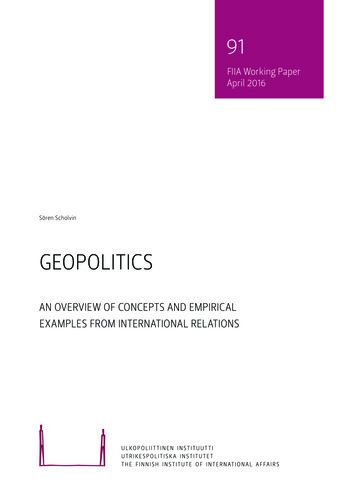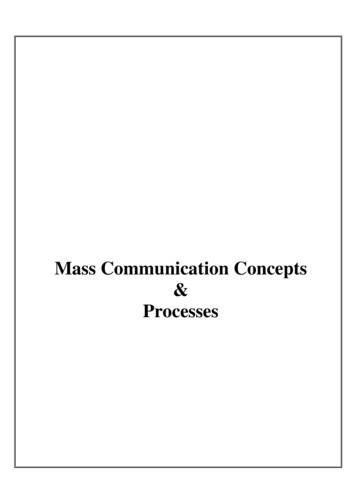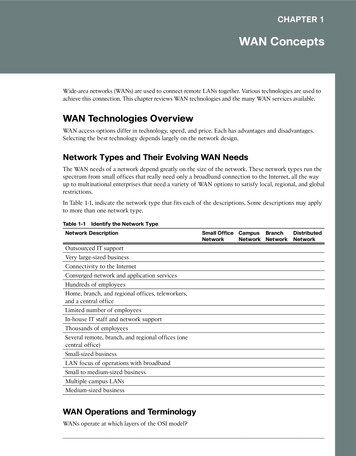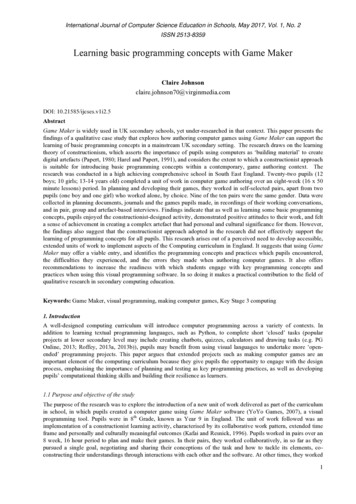
Transcription
91FIIA Working PaperApril 2016Sören ScholvinGEOPOLITICSAN OVERVIEW OF CONCEPTS AND EMPIRICALEXAMPLES FROM INTERNATIONAL RELATIONS
Sören ScholvinResearch fellowInstitute of Economic and Cultural Geography, University of HanoverAssociated researcherGerman Institute of Global and Area StudiesThe Finnish Institute of International AffairsKruunuvuorenkatu 4FI-00160 Helsinkitel. 358 9 432 7000fax. 358 9 432 7799www.fiia.fiISBN: 978-951-769-484-1ISSN: 2242-0444Language editing: Lynn NikkanenThe Finnish Institute of International Affairs is an independent researchinstitute that produces high-level research to support politicaldecision-making and public debate both nationally and internationally.All manuscripts are reviewed by at least two other experts in the fieldto ensure the high quality of the publications. In addition, publicationsundergo professional language checking and editing. The responsibilityfor the views expressed ultimately rests with the authors.
TABLE OF CONTENTSSUMMARY 4INTRODUCTION 5GEOPOLITICS IN THE PAST 8China’s string of pearls 10South Africa’s quiet diplomacy vis-à-vis Zimbabwe 12GEOPOLITICS IN THE PRESENT 16Iran’s strategy of asymmetric maritime warfare 18The poor integration of Colombia and South America 20THREE PILLARS OF GEOPOLITICS 243
SUMMARYGeopolitical research is frequently portrayed as a dead end. To some scholars it appearsthat in the 21st century geography is largely scenery, all but irrelevant to the mostimportant issues of grand strategy.This working paper aims to revitalise geopolitics, reflecting both on the critique ofthe subject and the strengths that have characterised it for more than a century. It isargued that geographical conditions constitute a set of opportunities and constraints, astructure that is independent of agency. General patterns and long-term processes canbe aptly explained by this structure but geopolitics is not a theory of state behaviour orforeign policy.Understanding specific phenomena that occur in international relations thereforerequires taking into consideration non-geographical factors. Such a combination ofgeographical and non-geographical factors provides sound explanations, as severalexamples demonstrate: China’s projection of power into the Indian Ocean, South Africa’sapproach to the political crisis in Zimbabwe in 2008, Iran’s maritime strategy and thepoor integration of Colombia and South America.Given that geopolitics is about analysing international relations (or politics) for itsgeographical content, all those committed to geopolitics should concentrate on the threeguiding questions: Do geographical conditions influence the observed outcome? If yes,do geographical conditions influence the observed outcome significantly? If yes, how,meaning in combination with which other factors do geographical conditions influencethe observed outcome?4
INTRODUCTION1Nicholas Spykman once wrote that ‘ministers come and go, even dictators die, butmountain ranges stand unperturbed’.2 Due to their persistence, Spykman regardedgeographical conditions – the physical reality that states face – as being decisive forinternational relations. This type of geopolitical thinking has been strongly criticised,more recently by constructivists such as John Agnew, Simon Dalby and Gearóid ÓTuathail,3 and for decades by realists. In an article recently published in the journalOrbis, Christopher Fettweis argues that geopolitics suffers from major descriptive,prescriptive and predictive deficiencies. According to Fettweis, geopolitics is thereforeunable to produce meaningful scholarly work.4 It has become obsolete, as he claims in anarticle published earlier in Comparative Strategy.5Yet there are several scholars who adhere to geopolitical explanations in their researchon international relations. Michael Klare, for example, focuses on the demand, supplyand spatial characteristics of resources in order to explain conflicts amongst states.6Robert Kaplan argues that we must study ‘the outside environment faced by everystate when determining its own strategy’.7 Others concentrate on territorial strategies,reasoning for instance that China and India are likely to clash because the ‘string ofpearls’ – that is, a line of commercial and military facilities constructed by the Chinesealong the shores of the Indian Ocean – cuts through sea lines of communication in the1This working paper is based on a presentation given by the author at a roundtable on ‘Geopolitics,Geoeconomics and Foreign Policy Analysis’ at the Finnish Institute of International Affairs, 6 October 2015.The author would like to thank the participants of the roundtable for their valuable comments.A shorter version of the working paper will be published under the title ‘Geographical Conditions andPolitical Outcomes’ in Comparative Strategy, vol. 35, no. 6.2Nicholas J. Spykman, America’s Strategy in World Politics: The United States and the Balance of Power(New York: Harcourt, 1942), p. 41.3The most important critiques of geopolitics by constructivists are: Gearóid Ó Tuathail and John A. Agnew,‘Geopolitics and Discourse: Practical Geopolitical Reasoning in American Foreign Policy’, Political Geography,vol. 11, no. 2 (1992), pp. 190–204; Gearóid Ó Tuathail and Simon Dalby, ‘Rethinking Geopolitics: Towards aCritical Geopolitics’, in Rethinking Geopolitics, ed. Gearóid Ó Tuathail and Simon Dalby (London: Routledge,1998), pp. 1–15.4Christopher J. Fettweis, ‘On Heartlands and Chessboards: Classical Geopolitics, Then and Now’, Orbis,vol. 59, no. 2 (2015), pp. 233–48.5Christopher J. Fettweis, ‘Revisiting Mackinder and Angell: The Obsolescence of Great Power Geopolitics’,Comparative Strategy, vol. 22, no. 2, pp. 109–22.6Michael T. Klare, Resource Wars: The New Landscape of Global Conflict (New York: Holt, 2002); Michael T.Klare, Blood and Oil: The Dangers and Consequences of America’s Growing Petroleum Dependency (London:Penguin, 2004); Michael T. Klare, Rising Powers, Shrinking Planet: The New Geopolitics of Energy (New York:Holt, 2009).7Robert D. Kaplan, The Revenge of Geography: What the Map Tells Us about Coming Conflicts and the BattleAgainst Fate (New York: Random House, 2012), p. 60.5
Arabian Sea and the Gulf of Bengal that are vital for India.8 In his critique of geopolitics,Fettweis suggests that ‘everyone agrees that geography matters [ ] but determiningexactly how the chessboard affects the game has proven elusive’.9 It is confusing whyFettweis – and many others along with him – concludes that we should stop thinkingabout how geographical conditions influence international relations. Even if one thinksthat the findings of geopolitics have been dissatisfying so far, the apparent importance ofgeographical conditions – which those who criticise geopolitics from a realist perspectiveacknowledge – should encourage us to refine geopolitical thinking.In contrast to other publications in defence of geopolitics, this working paper doesnot investigate whether the conclusions drawn by scholars such as Halford Mackinderand Nicholas Spykman were (and still are) accurate.10 Instead, this paper shows thatgeopolitical thinking has much to contribute to our understanding of internationalrelations insofar as it allows us to focus on crucial factors that are neglected by otherapproaches: naturally given and man-made material structures in the geographicalspace. It also demonstrates that those who criticise geopolitics misunderstand inparticular the classical branch in numerous ways. Nonetheless, critics such as Fettweisdo hint at some actual shortcomings of geopolitical thinking. This paper thereforeadvances a refined version of geopolitics, based on classical and contemporarygeopolitics. The three pillars of the version of geopolitics proposed here are:11 Geographical conditions must not be seen as an irreversible fate. They constitute aset of opportunities and constraints, meaning a structure independent of agency. General patterns and long-term processes can be aptly explained by geographicalconditions, but understanding specific phenomena that occur in internationalrelations requires taking into consideration intervening non-geographical factors. It is helpful to trace processes and to reveal causal mechanisms, concentrating onthe role of geography therein, so as to show that geographical conditions matterand in what way.In order to demonstrate that new insights can be gained from the revitalised versionof geopolitics developed in this paper, empirical examples from international relationsare given. The purpose of the respective sections in this working paper is to show thatgeographical conditions are highly relevant for some major phenomena in present-dayinternational relations. As just noted, such explanations would remain incomplete ifthey neglected intervening non-geographical factors. Hence, by shedding light on theinterplay between geographical and non-geographical factors, the examples given here8An example of this line of thinking is: David Scott, ‘The Great Power “Great Game” between India and China:“The Logic of Geography”’, Geopolitics, vol. 13, no. 1 (2008), pp. 1–26.9Fettweis, ‘On Heartlands and Chessboards’, p. 248.10 A good example of this line of reasoning is Colin S. Gray, ‘In Defence of the Heartland: Sir Halford Mackinderand His Critics a Hundred Years on’, Comparative Strategy, vol. 23, no. 1 (2004), pp. 1–23.11Sören Scholvin, The Geopolitics of Regional Power: Geography, Economics and Politics in Southern Africa(Farnham: Ashgate, 2014).6
illustrate that we can learn a lot from incorporating geographical conditions into ouranalyses of international relations, while recognising that geopolitics remains a valid anduseful discipline.This working paper consists of three sections. First, an overview of the classicalfundaments of geopolitics is provided, and leading and misleading tracks are delineated.The second section deals with present-day geopolitics and how it advances the classicalapproach. The third section focuses on whence the three pillars of geopolitics listedabove are derived, and discusses the prospects for future geopolitical research.7
GEOPOLITICS IN THE PASTGeopolitical reasoning dates back to ancient Greece. Aristotle derived the respectivepolitical systems of the Greek city states and their neighbouring empires and tribes fromclimatic conditions. Similar ideas were prominent in France during the Renaissance.Immanuel Kant also linked presumed characteristics of peoples to climatic factors. Inmodern social science this line of thinking received a boost when geopolitics becamethe predominant approach in research on international relations. German geographerFriedrich Ratzel conceptualised states as growing organisms.12 In an attempt to applyscientific laws from biology to international relations, he argued that states derived theirnational power – their capacity to survive in the international arena – from the land theycontrolled. Ratzel’s Swedish colleague, Rudolf Kjellén, coined the term geopolitics.13He defined it as the science of states as life forms, based on demographic, economic,political, social and geographical factors.In the inter-war period, Austrian and German disciples of Ratzel and Kjellén advancedgeopolitics as a popular science aimed at revising the Treaty of Versailles. Karl Haushoferargued that the German Reich, Italy and Japan did not possess sufficiently large nationalterritories and would be unable to survive if they did not expand.14 Haushofer andother German geographers sought to actively shape politics according to what theyregarded as the geographically given needs of the German Reich.15 They also advancedpartisan models of geopolitical regionalisation, suggesting that the German Reichpossessed a natural sphere of influence that covered Africa and Europe. Germany wasto be the industrial core of this sphere. Africa and the European periphery should play asubordinate role as providers of raw materials.16 Adhering to the Darwinist fundamentslaid down by Ratzel and Kjellén, Haushofer and his colleagues believed that weak statespursued defensive strategies and strong states – growing life forms that they were– naturally expanded.17 What is more, the German school of Geopolitics was ethnodeterminist and incorporated ideologies as a causal factor. Haushofer argued that the riseand fall of states not only depended on the living space they controlled, but also on their12Friedrich Ratzel, Politische Geographie (München: Oldenbourg, 1897).13Rudolf Kjellén, Staten som livsform (Stockholm: Geber, 1916).14 Karl Haushofer, ‘Atemweite, Lebensraum und Gleichberechtigung auf Erden’, Zeitschrift für Geopolitik,vol. 11, no. 1 (1934), pp. 1–14.15Karl Haushofer, ‘Grundlagen, Wesen und Ziele der Geopolitik’, in Bausteine zur Geopolitik, ed. Karl Haushoferet al. (Berlin: Vowinckel, 1928), pp. 29–48.16 Erich Obst, ‘Ostbewegung und afrikanische Kolonisation als Teilaufgaben einer abendländischenGroßraumpolitik’, Zeitschrift für Erdkunde, vol. 9, no. 9 (1941), pp. 265–78.17Karl Haushofer, Japan baut sein Reich (Berlin: Zeitgeschichte-Verlag, 1941); Otto Maul, Die VereinigtenStaaten von Amerika als Großreich: Länderkunde und Geopolitik (Berlin: De Gruyter, 1940).8
urge to live.18 The pan-regions that he and other authors of the Zeitschrift für Geopolitikdescribed were supposedly based on pan-ideas.19American and British scholars conversely explained the long-term courses ofinternational relations in terms of geographical conditions, usually without referringto Social Darwinist thoughts and without adapting their academic findings to politicalgoals. Fettweis correctly points out that early Anglo-American geopolitics also had aclimate-racist branch: Ellsworth Huntington, for example, argued that peoples fromtemperate zones were superior to others because of climatic factors that presumablyformed their character.20 Thoughts on the impact of physio-geographical conditions onthe character of peoples were somewhat latent in Anglo-American classical geopolitics.Yet they never dominated the discipline. It was not climate and intellectual capacitiesbut, rather, the effects of locational, geomorphological and topographical conditionsfor national expansion and national power that were regarded as being essential. AlfredMahan, the first director of the US Naval War College, pointed out that the failure ofFrance to outcompete Britain in terms of naval power resulted from the fact that France’scoast is not conducive to building harbours. France, being located on the Europeancontinent, also had to invest in its army and navy, while the British could concentrateon naval power. Moreover, the French naval forces were divided into two arenas: theAtlantic coast and the English Channel, on the one side, and the Mediterranean Sea, onthe other. The Royal Navy, conversely, could concentrate its power on a single theatre ofoperation.2118 Karl Haushofer, Geopolitik des Pazifischen Ozeans: Studien über die Wechselbeziehungen zwischenGeographie und Geschichte (Heidelberg: Vonwinckel, 1924).19 Friedrich Paulig, ‘Monroe-Doktrin, Panamerika und Völkerbund’, Zeitschrift für Geopolitik, vol. 7, no. 1(1930), pp. 319–23; Frank H. Schmolck, ‘Der Panamerikanismus von Amerika aus’, Zeitschrift für Geopolitik,vol. 14, no. 5 (1937), pp. 381–88.Concerning German geopolitics it is noteworthy that its proponents, in particular Haushofer, were not greyeminences behind National Socialism. This is best demonstrated by Haushofer’s conviction of the merits ofan alliance with the Soviet Union and the complete failure of the so-called Working Group on Geopoliticsto influence foreign policy and public opinion in Germany in the 1930s (Hans-Adolf Jacobsen, ‘“Kampf umLebensraum”: Zur Rolle des Geopolitikers Karl Haushofer im Dritten Reich’, German Studies Review, vol. 4,no. 1 (1981), pp. 79–104.).20 Ellsworth Huntington, Civilization and Climate (New Haven: Archon, 1915).21Alfred T. Mahan, The Influence of Sea Power Upon History, 1660–1783 (London: Low, 1890).Ellen Semple – who went to Leipzig in the late 19th century to attend Ratzel’s university lectures –advanced similar ideas, arguing that the coastal geomorphology of the northern Atlantic Ocean, meaningthat ocean’s numerous inlets and small islands, was favourable to seafaring. Physio-geographicalconditions thus helped her to explain the expansion of European powers. Semple also reasoned on theimpact of environmental conditions on the human mind (American History and its Geographic Conditions(Boston: Mifflin, 1903)), as did her Scottish colleague James Fairgrieve (Geography and World Power(London: University of London Press, 1917)). Semple’s famous phrase – ‘man is a product of the earth’ssurface’ – duly summarises a problematic geodeterminism (Influences of Geographic Environment: On theBasis of Ratzel’s System of Anthropo-Geography (New York: Holt, 1911), p. 1).9
China’s string of pearlsIn 2010 China became the world’s major energy consumer. In particular, its oil importshave continued to increase at an impressive rate. Given that roughly 50 per cent of theoil that China imports comes from the Persian Gulf region, the People’s Republic has anevident interest in secure maritime transport through the Indian Ocean. Increasing importsof raw materials from Africa (in particular coal, metals and oil) reinforce this interest. Chinahas to react to threats such as piracy off the Horn of Africa. India’s naval build-up and thepresence of the US navy at chokepoints in Southeast Asia, where China can be cut off fromthe Indian Ocean, arguably also require a reaction from the Chinese.China’s projection of power into the Indian Ocean is, however, extremely difficult – andthis brings us back to Mahan. First of all, the main theatre of operation for the Chinesenavy is the Pacific Ocean, with its numerous territorial disputes close to the littoralstate of the People’s Republic. China’s capacities for the Indian Ocean are hence limited.Moreover, China does not possess a coastline of its own on that ocean. The aforementionedchokepoints in Southeast Asia can easily be used to cut off Chinese ships from supplies.In order to be able to operate in the Indian Ocean, the Chinese have thus begun to buildand upgrade ports in friendly countries, ranging from Cambodia to Myanmar to Pakistan.The most famous harbours of the so-called string of pearls are Gwadar (Pakistan) andKyaukpyu (Myanmar), which are to be linked to China by land corridors, including pipelines.The envisaged pipelines are strategically important because they would significantly reducetransport time from the Middle Eastern oil suppliers to the People’s Republic. They would,of course, also enable China to circumvent the Southeast Asian chokepoints. In the case ofGwadar, potential obstructions by the Indian navy would be reduced to a minimum.Whereas geographical conditions facilitate our understanding of why China has beenbuilding the string of pearls, they do not tell us what its precise effects are. India and thinktanks from the United States in particular warn against China’s power projection into theIndian Ocean. Kaplan attributes the string of pearls directly to China’s quest for secureaccess to resources.1 Referring to Mackinder’s heartland theory, Kaplan also argues thatthe People’s Republic possesses highly favourable geographical conditions to raise it to thestatus of a world power.2 However, the geographical advantages that Kaplan refers to donot necessarily mean that China’s rise will be competitive (or even war-prone). The portsthat are being built or rehabilitated by the Chinese along the Indian Ocean could serve aseconomic growth poles, with Chinese companies investing in free-trade zones at theseports, co-operating with local companies and incorporating them into global commoditychains – Gwadar, for example, is already a free-trade zone today.Moreover, caution is needed because the string of pearls is not a security paradigmdeveloped by the Chinese. It was coined by the consultancy Booz Allen Hamilton in 2004and brought to a larger audience shortly afterwards by the Washington Post, which wronglypictured it as a Chinese security paradigm (and not an analytical concept developed in the1Robert D. Kaplan, Monsoon: The Indian Ocean and the Future of American Power (New York: RandomHouse, 2010).2Robert D. Kaplan, ‘The Geography of Chinese Power: How Far Can Beijing Reach on Land and at Sea?’,Foreign Affairs, vol. 89, no. 3 (2010), pp. 22–41.10
United States). Chinese politicians speak of the ‘new silk road’, stressing prospects foreconomic co-operation instead of security issues. This does not mean that the stringof pearls falls short as a description of China’s strategy, or that the aforementionedgeographical factors are irrelevant. Yet we have to include non-geographical factors inorder to gain a complete picture of what the Chinese are doing in the Indian Ocean.Chittagong:Chinese credits for harbour project, possibly transport corridor to ChinaGreat Coco Island: Chinese airfield and presumptive listening postGwadar:run by Chinese companies, transport corridor to ChinaHambantota:Chinese credits for harbour project, speculation on military useKra Isthmus:scheduled channel, construction possibly by Chinese companiesKyaukpyu:harbour financed by China, transport corridor to ChinaLamu:harbour built by Chinese companies, transport corridor to hinterland plannedMarao:speculation on Chinese submarine basePort Sudan:oil terminal and rail corridor to hinterland, visits by Chinese navySanya:submarine baseSihanoukville:special economic zone, visits by Chinese navySpratly Islands:construction of harbours and airfields, partly on artificial islandsWoody Island:harbour and airfields for military useMap 1: The string of pearls. Source: Author’s own compilation.Half a century after Mahan had published his main work, Nicholas Spykman wrote that‘it is the geographical location of a country and its relations to centers of military powerthat define its problem[s] of security’.22 Topography is critical too: landlocked states,island states and states that possess land and sea borders pursue different strategies innational defence.23 Beyond that, Spykman attributed national expansion to topography.He pointed out, for instance, that the ancient Greek city states had to become maritimepowers after having settled their respective valleys because mountain ranges hamperedany further expansion on land.2422 Spykman, America’s Strategy, p. 447.23 Nicholas J. Spykman, ‘Geography and Foreign Policy II’, American Political Science Review, vol. 32, no. 2(1938), pp. 213–36. Robert Jervis adapted this idea in his seminal article on ‘Cooperation under the SecurityDilemma’ (World Politics, vol. 30, no. 2 (1978), pp. 167–214), suggesting that ‘if all states were self-sufficientislands, anarchy would be much less of a problem’ (p. 195).24 Nicholas J. Spykman, ‘Geography and Foreign Policy I’, American Political Science Review, vol. 32, no. 1(1938), pp. 28–50.11
South Africa’s quiet diplomacy vis-à-vis ZimbabweIn the course of the presidential elections in 2008, Zimbabwe entered a state of violentpolitical crisis. President Robert Mugabe and the ruling party, the Zimbabwe AfricanNational Union – Patriotic Front (ZANU PF), led a repression campaign against theopposition party and its supporters in the run-up to the electoral process. State-sponsoredviolence resulted in massive human rights violations, in particular after Mugabe and ZANUPF had lost the first election round. The regional response to the crisis was minimal andconsidered inadequate by Western governments and non-governmental organisations.The key characteristic of South Africa’s approach to the crisis in Zimbabwe was thatthe governments of Thabo Mbeki and Jacob Zuma did not criticise their Zimbabweancounterpart directly – unlike many Western politicians. Mbeki publicly called on theSouthern African Development Community (SADC) to take action in order to preventZimbabwe from descending into chaos when the Zimbabwean government refused toallow election monitors into the country. Other than that, South African politicians tried tomediate behind closed doors, applying maximum subtle pressure on Zimbabwe.Political factors exist that explain South Africa’s approach to Zimbabwe, which has beenlabelled ‘quiet diplomacy’. First of all, there is considerable sympathy in South Africa forZimbabwe’s fast track land reform (that is, violent invasions of commercial farms ownedby white farmers). It is seen as a role model by left-wing politicians of the African NationalCongress (ANC) and the recently founded Economic Freedom Fighters. Moreover, given thestrong criticism by African governments that Nelson Mandela had faced for his clear standagainst human rights violations in Nigeria in 1995, the Mbeki government wanted to avoidbeing seen as a proxy of the West. Probably for both reasons, Kgalema Motlanthe, the thensecretary general of the ANC, argued that the Zimbabwean government was in trouble notbecause it did not care about ordinary Zimbabweans but because it cared too much. Mbekisimilarly declared that the Zimbabwean crisis had arisen from a genuine concern to meetthe needs of the black poor.1Quiet diplomacy also has something to do with geographical conditions. Westernstates, being far away from Zimbabwe, can indulge in harsh criticism of Mugabe and hisgovernment. South Africa, conversely, is directly affected by everything that happens inZimbabwe because of its location. In 2010 South African experts estimated that about fourmillion Zimbabweans, out of a population of 17 million, were legally and illegally in SouthAfrica.2 Many of them had fled from political violence. The less stable Zimbabwe became,the more Zimbabweans went to South Africa. Attacks against foreigners in townships –who were supposedly stealing jobs from South Africans – increased.3 Some officials ofthe Congress of South African Trade Unions, which forms an alliance with the ANC andthus participates in the national government, called for protecting South African workers1Ian Phimister and Brian Raftopoulos, ‘Mugabe, Mbeki & the Politics of Anti-Imperialism’, Review ofAfrican Economy, no. 101 (2004), pp. 385–400.2Scholvin, Geopolitics of Regional Power.3Karl von Holdt et al., ‘The Smoke that Calls: Insurgent Citizenship, Collective Violence and the Strugglefor a Place in the New South Africa’, www.csvr.org.za/docs/thesmokethatcalls.pdf (accessed 8November 2015).12
against foreign competition. Furthermore, regional transport by rail and road – and hencethe lucrative expansion of South African companies into the SADC region – depends onZimbabwe, which is the region’s major transit country. Plans to better interlink the regionalelectricity grids, easing South Africa’s electricity shortage, also rely on Zimbabwe, as allexisting major transregional transmission lines pass through Zimbabwean territory. All ofthis would be jeopardised if South Africa pursued an approach other than quiet diplomacy.44Maxi Schoeman and Chris Alden, ‘The Hegemon that Wasn’t: South Africa’s Foreign Policy towardsZimbabwe’, Strategic Review for Southern Africa, vol. 25, no. 1 (2003).In sum, the Anglo-American branch of classical geopolitics was primarily aboutunderstanding politics based on considerations of location and physical geography andproviding advice to politicians accordingly.25 Halford Mackinder made this epistemologymost explicit, saying that ‘geographical features govern or, at least, guide history’.26This does not mean that nature mechanically dictates the decisions made by humans. Toquote Mackinder, ‘man and not nature initiates, but nature in large measure controls’.27Fettweis and many other critics unfortunately miss this crucial limitation of theexplanatory force that the proponents of classical geopolitics – some more than others –ascribed to nature.Fettweis also claims that for adherents of geopolitics ‘the earth is the most basicinfluence on state behavior’.28 Geopolitics has, according to Fettweis, ‘always selfconsciously been’ a theory of foreign policy.29 Yet following Mackinder’s quote,geopolitics is not a science of foreign policy, nor state behaviour. It only deals withgeographically given obstacles to, and opportunities for, successful policies. Humanactors initiate policies; this behaviour is not analysed by geopolitics. Mackinder stressedin the discussion of his famous paper on The Geographical Pivot of History that he aimed‘to make a geographical formula into which you could fit any political balance’:30 heattributed the respective strengths and weaknesses of continental and maritime powers25 One might, of course, argue that there are differences between classical geopolitics in Britain, on theone hand, and in the United States, on the other. Mackinder and his disciples concentrated on physicalbarriers and resources that characterise Eurasia. Mahan and other adherents of classical geopolitics in theNew World were much more interested in the foreign-trade orientation of major powers and sea lanes,including chokepoints, as strategic assets. These different perspectives have had an influence on Europeanand US security policy until today. On a meta-level, classical geopolitics in Britain and the United States is,however, based on the same scientific convictions.26 Halford J. Mackinder, ‘The Physical Basis of Political Geography’, Scottish Geographical Magazine, vol. 6,no. 2 (1890), p. 78.27 Halford J. Mackinder, ‘The Geographical Pivot of History’, Geographical Journal, vol. 23, no. 4 (1904), p. 422.28 Fettweis, ‘On Heartlands and Chessboards’, p. 237.29 Fettweis, ‘Revisiting Mackinder and Angell’, pp. 119–20.30 Mackinder, ‘The Geographical Pivot’, p. 443.13
to locational and physio-geographical conditions; he did not seek to explain everydaypolitics this way.Furthermore, Fettweis summarises Mackinder by saying that ‘geographi
In order to demonstrate that new insights can be gained from the revitalised version of geopolitics developed in this paper, empirical examples from international relations are given. The purpose of the respective sections in this working paper is to show that geographical conditions ar











